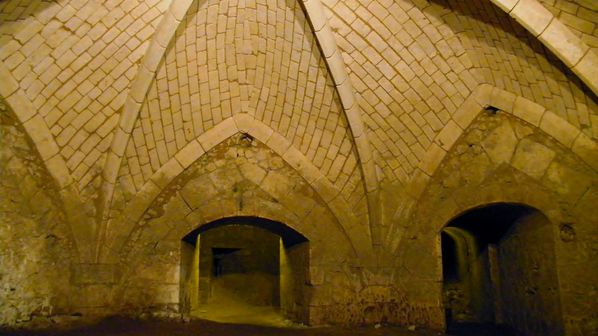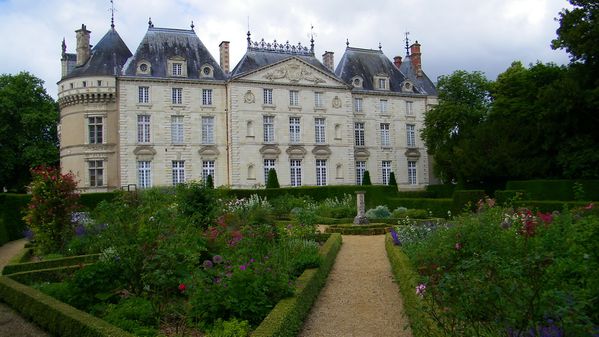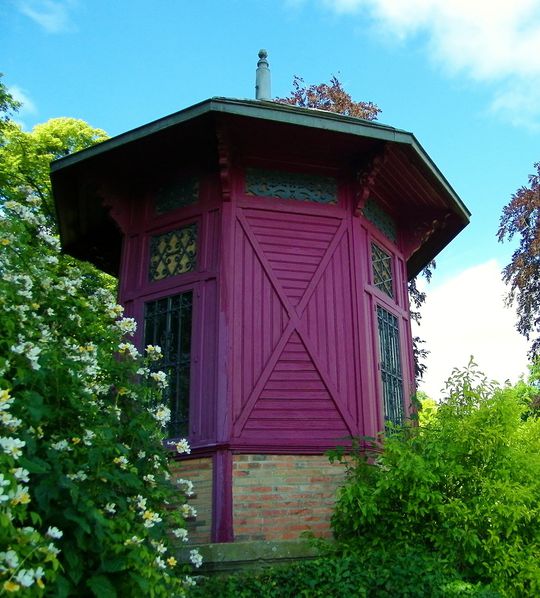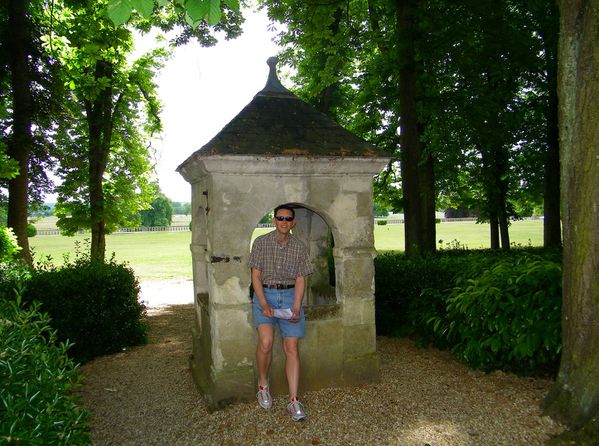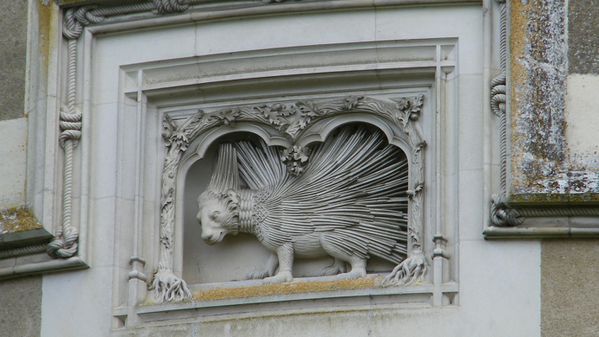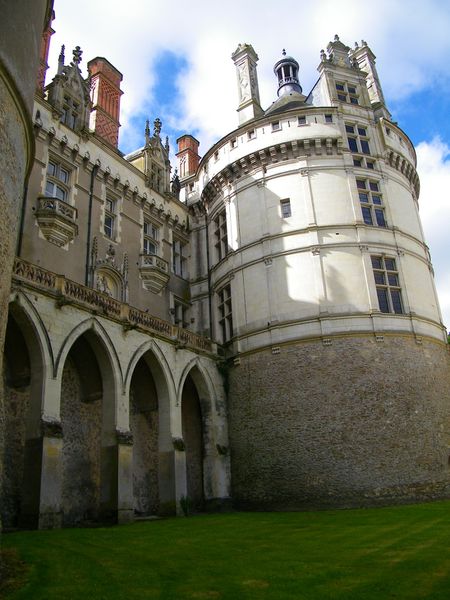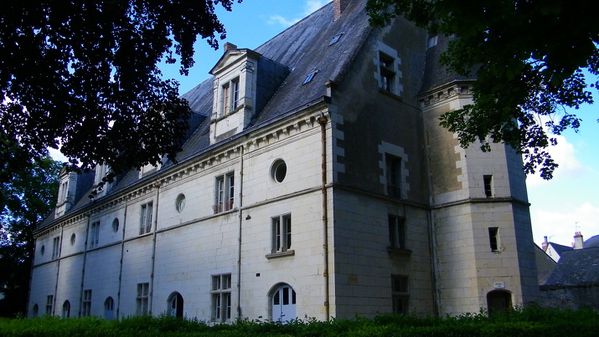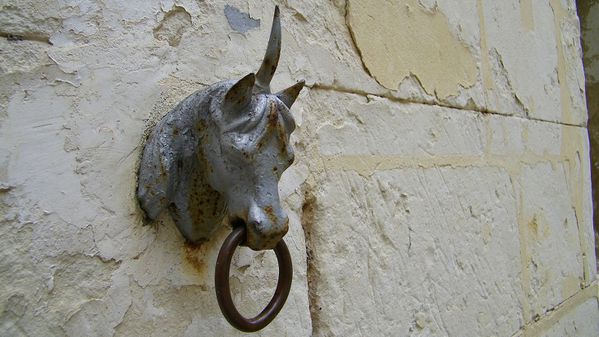
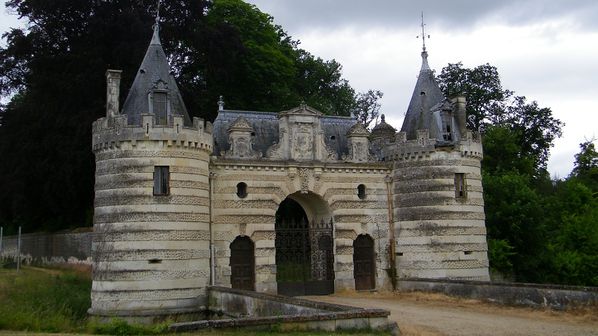



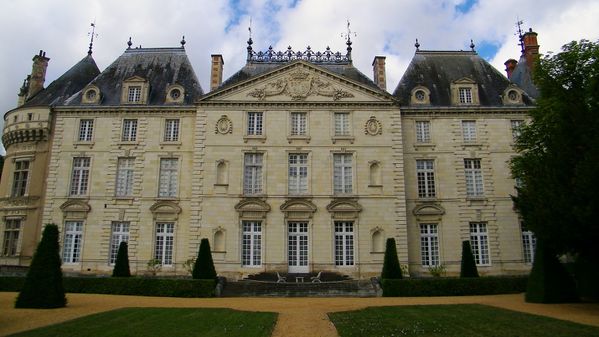

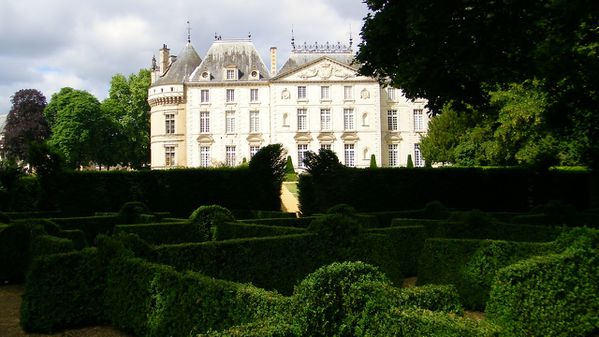
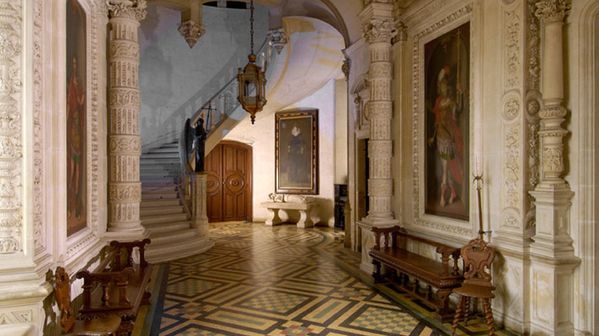 The Entrance Hall is decorated in the Renaissance style and portrays four paintings from the 15th century Italian School representing the Evangelists. The ceiling includes the Daillon coat of arms which alternates with the letter D.
The Entrance Hall is decorated in the Renaissance style and portrays four paintings from the 15th century Italian School representing the Evangelists. The ceiling includes the Daillon coat of arms which alternates with the letter D.  At the foot of the staircase is a bronze statue called the Angel of Le Lude, which was part of the decorative scheme of the Sainte-Chapelle in Paris. It was sold in the 19th century by the Marquis de Talhouët-Roy to pay for the restoration of the roofs.
At the foot of the staircase is a bronze statue called the Angel of Le Lude, which was part of the decorative scheme of the Sainte-Chapelle in Paris. It was sold in the 19th century by the Marquis de Talhouët-Roy to pay for the restoration of the roofs.  The large library was decorated in the 19th century. It protects the impressive book collection of the Duke de Bouillon. There are over 2,000 books, the oldest dating to the 16th century. In the middle of the room is a statue of the Count Roy, Minister of Finance to Louis XVIII and Charles X.
The large library was decorated in the 19th century. It protects the impressive book collection of the Duke de Bouillon. There are over 2,000 books, the oldest dating to the 16th century. In the middle of the room is a statue of the Count Roy, Minister of Finance to Louis XVIII and Charles X.  The Renaissance style ballroom contains the oldest furniture in the château. On the other side of the chimney are two royal portraits, representing the regent of France, Duke d’Orléans, nephew of Louis XIV and his wife, Mademoiselle de Blois, daughter of Louis XIV. Opposite are four costumes entirely hand-embroidered, dating back to the 18th century. The large 19th century writing desk belonged to the Count Roy. The large bronze gate at the end of the room was presented to the artisans of the town to the Marquis de Talhouët-Roy at the end of their restoration work in the château. The Blue Room is the first room of the 18th century wing. It contains the family portraits of the Talhouët family. The furniture dates back to the era of Louis XIV and Louis XVI.
The Renaissance style ballroom contains the oldest furniture in the château. On the other side of the chimney are two royal portraits, representing the regent of France, Duke d’Orléans, nephew of Louis XIV and his wife, Mademoiselle de Blois, daughter of Louis XIV. Opposite are four costumes entirely hand-embroidered, dating back to the 18th century. The large 19th century writing desk belonged to the Count Roy. The large bronze gate at the end of the room was presented to the artisans of the town to the Marquis de Talhouët-Roy at the end of their restoration work in the château. The Blue Room is the first room of the 18th century wing. It contains the family portraits of the Talhouët family. The furniture dates back to the era of Louis XIV and Louis XVI.  This is the Main Reception Room of the château. In each corner are large mirrors, toning down the angles and enlarging the room. The Chinese porcelain ornaments of the 18th century belonged to Mr. Duvalaër, the ship owner of the Compagnie des Indes. The chandelier made from German crystal weighs one ton. The two paintings on either side of the chimney can be attributed to François Boucher. The next room is the Small Room where one can find the family portraits from the 17th century to the present day. On the stand is a portrait of the Countess Renée de Nicolaÿ.
This is the Main Reception Room of the château. In each corner are large mirrors, toning down the angles and enlarging the room. The Chinese porcelain ornaments of the 18th century belonged to Mr. Duvalaër, the ship owner of the Compagnie des Indes. The chandelier made from German crystal weighs one ton. The two paintings on either side of the chimney can be attributed to François Boucher. The next room is the Small Room where one can find the family portraits from the 17th century to the present day. On the stand is a portrait of the Countess Renée de Nicolaÿ.  The Flemish cabinet, made from ebony, dates back from the 17th century and is decorated with Biblical scenes. The Music Room complements, once again, the magnificent Renaissance style seen throughout the château. On the walls are Gobelins tapestries dating from the 17th century. The furniture, upholstered in Beauvais tapestry, dates from the 18th century. In front of the window stands a marble bust of the Cardinal de la Tour d’Auvergne (18th century), who was a cousin of the Duke de Bouillon.
The Flemish cabinet, made from ebony, dates back from the 17th century and is decorated with Biblical scenes. The Music Room complements, once again, the magnificent Renaissance style seen throughout the château. On the walls are Gobelins tapestries dating from the 17th century. The furniture, upholstered in Beauvais tapestry, dates from the 18th century. In front of the window stands a marble bust of the Cardinal de la Tour d’Auvergne (18th century), who was a cousin of the Duke de Bouillon. 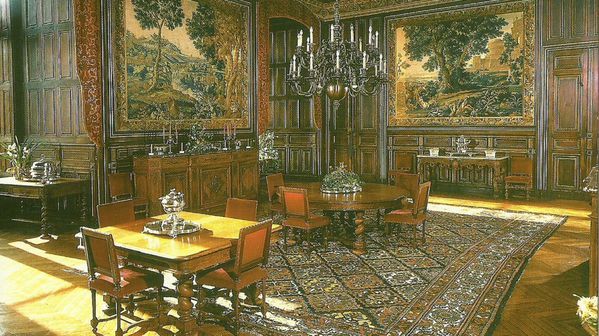 On the walls of the Dining Room hang large Flemish tapestries from the 17th century. They were hidden under the floorboards during the Revolution and found 80 years later during the restoration of the château. The huge chimney place bears the emblem of François I, the salamander and his wife, Claude de France, the ermine. The bronze chandelier dates from the 17th century and originates from Holland.
On the walls of the Dining Room hang large Flemish tapestries from the 17th century. They were hidden under the floorboards during the Revolution and found 80 years later during the restoration of the château. The huge chimney place bears the emblem of François I, the salamander and his wife, Claude de France, the ermine. The bronze chandelier dates from the 17th century and originates from Holland. 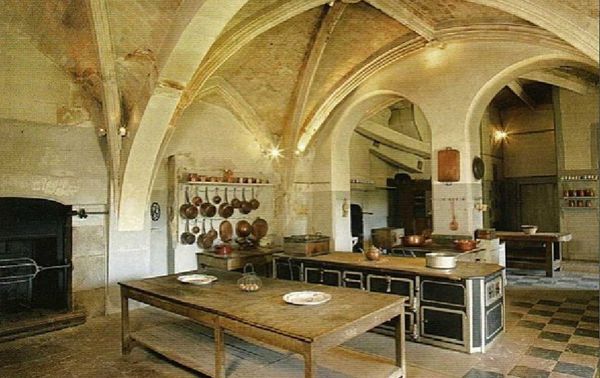 The large Kitchens are arranged in a 15th century room. Here one can admire the arched ceilings. The kitchens were in use up until 1945. Their restoration in 1993 has re-emphasised its architecture and its original furniture.
The large Kitchens are arranged in a 15th century room. Here one can admire the arched ceilings. The kitchens were in use up until 1945. Their restoration in 1993 has re-emphasised its architecture and its original furniture. 
 One can find here: two large chimneys and their turning spits, the oven for baking bread, the kitchen range with its twelve ovens and Bain-marie, a dumb waiter, stone sink and the wood furnace, built at the end of the 19th century to heat the first floor rooms.
One can find here: two large chimneys and their turning spits, the oven for baking bread, the kitchen range with its twelve ovens and Bain-marie, a dumb waiter, stone sink and the wood furnace, built at the end of the 19th century to heat the first floor rooms. 